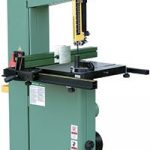We may receive a commission when you use our affiliate links. However, this does not impact our recommendations.

Thanks to the steady stream of tools that flow in and out of our shop, I do a lot of sharpening. I set up more tools from scratch than I care to admit. And I wear out sharpening stones.
Last week I noticed that my #1,000-grit Shapton Glasstone was getting wafer thin. This is the second #1,000-grit Glasstone I’ve burned through in the last few years, and it brings up something that has irked me about some brands of sharpening stones sold in North America.
Here is my gripe: Why would anyone sell stones that are all the same thickness? Perhaps I’m missing something, but I think that’s odd.
Your coarse stones, such as #1,000, wear away quickly. I’ve probably burned through five since 1993. These stones should be thick. Give me at least an 1″ of thickness, and I’ll be your best friend. I know some manufacturers are smart about this, but not all are.
The finer stones should be thinner. I’ve used up only two #4,000-grit stones since 1993. Make one that is 1/2″ to 5/8″ thick, and I bet most woodworkers would have a lifetime stone.
The finest polishing stones can be wafer thin , 1/8″ mounted on some kind of plastic base or glass would be fine with me. I have yet to use up an #8,000-grit stone. So giving me less of this abrasive is fine by me.
I think this approach works on the money side of things, as well. The coarse stones are the least expensive. The finer stones are the most expensive.
That’s all the bile I have this week. I’m off on vacation as of …. now. I won’t be able to monitor my e-mail or this blog, so if you have any problems, you’ll be better off contacting the other staff members.
– Christopher Schwarz
Want instruction on how to wear out your sharpening stones? That’s easy , sharpen a lot of tools. Here are a couple stories I’ve written on sharpening methods, and a link to Rob Hock’s excellent new book on sharpening just about any kind of tool.
– “A Better Way to Sharpen Scrapers“
– “The Perfect Edge,” by Ron Hock , This book will change the way you think about “sharp.”
Here are some supplies and tools we find essential in our everyday work around the shop. We may receive a commission from sales referred by our links; however, we have carefully selected these products for their usefulness and quality.









I’ve recently tried one of the new thicker Shapton glass stones in the 500 grit and once I have the geometry set at that level I can fly through the rest of the stones in less than 20 strokes on each. Getting the geometry set first makes it so simple, even on a set of Nagahiro(Amazingly hard steel) Chu-Tataki chisels made in the early 90s.
Paul
I’ve been using the same 2 sided stone for 35 years. Mostly I use just the fine side, for everything (straight edged, not gouges).
My (freehand) sharpening seems OK to me and I don’t understand what all the modern sharpening fuss is about and why it has become so difficult!
The real question here is "How sharp is ‘sharp’"? It is my contention that if you can shave the hair on your arm with it, it is sharp enough to cut wood. I learned how to repair airplanes when they were still made out of pipe, bedsheets and fence posts. We did a lot of woodwork. I sharpened my chisels and plane blades using the shop grinding wheel to remove the nicks and a two-grit whetstone to hone the edge. Yes, this equipment did get the edge sharp enough to dry-shave with. Why do we need all the fancy waterstones and stuff to do the same job?
James,
That’s hilarious!
I’m getting flashbacks from Seinfeld…
Megan, are you sure he’s expunge-worthy?
But David – just remember that in Chris’s absence, I’ve the power to impugn…and expunge 😉
I’m sure we all have great solutions to Chris’s problem. But it really isn’t a problem. I doubt that replacing 5 sharpening stones since 93 is a major part of his budge.
Chris is just pointing that course stones wear out faster than fine stones, so it is odd that "some" North American brands sell all of their stones in the same thickness. It might not be worth an entire article in Popular Woodworking Magazine, but it makes for an interesting blog.
However, since Chris is on vacation, I can call him childish names him with impunity. I think Chris is a stupid-head!
-David
Wouldn’t going with the Shapton Professional Series be a reasonable solution? Much thicker stone, without the glass backing support that defines the Glass Stone series.
Hi. I agtee with Kevin. I also like sandpaper more than stones. For one, they are cheaper. But I guess this is more of a matter of preference rather than which one is actually better. Try it and it might solve the problem.
One of the many reason I moved from stones to sandpaper… wet/dry abrasive paper on a granite slab, followed by green honing compound on a piece of leather glued to some mdf. According to my research ANSI 1500 grit is around 6000 Japanese, and green honing compound has the same micron size as the 16,000 grit Shapton. While that was off the interwebs and might not be totally accurate, the blades get sharper that way than when I used my 8000 grit waterstone. Try it, sandpaper is cheap, and you can use it for other stuff too.
-Kevin
Wayyyy back in the ’80’s I bought a set of japanese water stones from Woodcraft. Or from somewhere. They were around 1.5 inches in thickness. I suspect the makers wised up and realized that the thicker stones didn’t make as much of a profit for them as did the thinner ones.
Have a nice vacation Chris, and thanks.
I dunno, Chris. I think you’re dealing with another nifty American tradition… that wonderful cereal box prize tradition of "collect all three!"
You don’t need to work in sets. You could buy the full thickness coarse stone, and the glass stone versions of the finer grits.
Better yet, you could buy the coarse Norton, which is thicker, (1", per your spec) coarser, cheaper, and easier to flatten, and use that in conjunction with the glass stones, or other options.
Or you could do the coarse Norton, the medium shapton, and then once the iron is dry, and with established planar surfaces, run through a series of diamond paste MDF strops.
Or whatever else.
At one point, when I was doing a lot of sharpening, I was mostly diamond stropping. And when I needed to re-establish an edge, I was hollow grinding on the coarse wheel, establishing a quick bevel with a medium grit Norton water stone, and then drying the tool so the MDF diamond strops wouldn’t get wet. Fast enough, easy, and very highly refined edge. I still bounce around between those, shaptons, tormek, whatever. But there’s nothing sacred about using a homogenous set of all "XXXXX" brand stones.
The coarse stone in particular is actually the one that has so little significance in terms of brand. You just need something that will brutally remove material. There’s nothing really special about the Shapton coarse stone, or the surface it creates, since it will then be removed by finer grits anyway. It’s only the surface left by the last pass, on the last stone, that really matters. And there are a lot of "supporting cast" stones that will help you get there. Nothing really crucial about brand, though.
I remember reading somewhere that Konrad Sauer went with HC irons over fancier, harder steel, because they were easier to sharpen, and so he was more likely to do it. Rather than push his luck with a harder iron to just get that last pass in, he could touch up the HC fast enogh that it really wouldn’t slow him down. Using similar logic, Shapton’s long-wearing, hard to flatten coarse stones are just as much of a hindrance to good sharpening. You need it to be flat. But, coarse stones don’t stay flat for very long, so it’s almost better to stick with something cheaper and softer that you can flatten more easily, so you’re more likely to do it. (or at least, that’s my experience.)
Chris – I think you covered it. Since 1993, you’ve burned through five of the stones. That means you’ve bought five stones. Whoever you’ve bought them from probably considers them to be a far superior product that you would buy once for slightly more.
The only long-wearing medium stones I can think of are the porous ceramics. Still have to soak them (not nearly as long as king soak time, though), but they’re 5 times as thick as the glasstones and bigger for about the same price.
If you don’t use them up, would you buy a new one from me?
Duh.
Chris,
It looks to me like your daughter is wearing them out.
Have a good vacation, Chris!